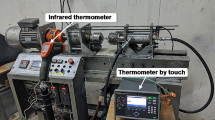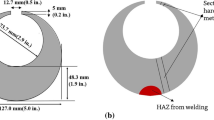Conclusions
-
1.
To obtain a higher hardness (>HRC 63) and heat resistance (>HRC 59 at 620°C for 4 h) the holding time for quenching steel R6M5 should be 25% longer than for steel R18. The optimal quenching temperature, producing a grain size of grade 11–10, is 1220–1240°C.
-
2.
Steel R6M5 must be protected against decarburizing during heating to quenching temperature. The salt bath should be rectified (deoxidized) with magnesium fluoride or borax.
-
3.
The optimal tempering conditions for the highest hardness and mechanical properties are tempering at 350° and double tempering at 560–570° for 1 h. For tools subject to attrition (without impact) it is recommended that tempering be conducted at 540–550° twice or three times for 1 h to provide higher hardness and heat resistance. The heat treatment recommended for steel R6M5 increases the durability of tools by 25–30%.
Similar content being viewed by others
Literature cited
E. A. Smol'nikov, "How to calculate the heating time for quenching," Metal. i Term. Obrabotka Metal., 12, 53–65 (1970).
Yu. A. Geller and L. P. Pavlova, "Effect of termpering on precipitation hardening of high-speed steels," Metal. i Term. Obrabotka Metal. 4, 43–44 (1967).
Additional information
Moscow Machine-Tool Institute. Translated from Metallovedenie i Termicheskaya Obrabotka Metallov, No. 11, pp. 15–17, November, 1973.
Rights and permissions
About this article
Cite this article
Aleksandrovich, B.L. Heat treatment of high-speed steel R6M5. Met Sci Heat Treat 15, 939–941 (1973). https://doi.org/10.1007/BF00656674
Issue Date:
DOI: https://doi.org/10.1007/BF00656674




